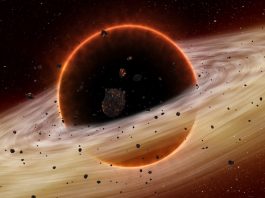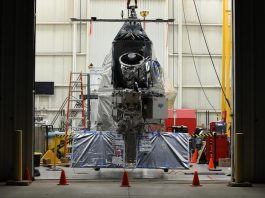Angela Dietz, Spacecraft Operations Engineer at the European Space Agency, spoke with The Innovation Platform ahead of the JUICE mission’s pioneering lunar-earth flyby.
The JUICE mission, launched in April 2023, is focused on exploring Jupiter’s moons, particularly three out of the four large Galilean moons: Callisto, Europa, and Ganymede. These are of particular interest because of their thick ice crusts, beneath which lies a vast amount of water. Ganymede, the largest moon, is even bigger than the planet Mercury and is believed to contain six times more water than Earth. This possibility has led scientists to speculate about the potential for life below the surface. The icy moons around Jupiter, in particular Jupiter’s moon Europa, are among the most likely places to support life in the solar system, with the chances of finding it being similar to the probabilities associated with Mars.
While these moons have not been explored extensively before, previous missions, such as the Voyager flybys and the American mission, Juno, have provided valuable first insights. With NASA’s Europa Clipper, even another American mission targets a launch date in the fall of this year, with a particular focus on Europa. Juice will focus on the three icy moons around Jupiter before orbiting Ganymede, which is particularly intriguing due to its magnetic field. With JUICE and Europa Clipper operating simultaneously in the same system and possessing similar instruments, there is a unique opportunity to conduct measurements together.
Lunar-earth flyby
This ambitious undertaking spans nearly eight years and involves four scheduled flybys – three past Earth and one past Venus – before finally reaching the Jupiter system. Meticulous planning over the last twenty years led to the development of a route utilising these complex gravity assist manoeuvres rather than aiming towards the outer solar system on a more direct trajectory. This approach has the benefit of minimising the required propellant onboard and meeting the performance envelope of the Ariane launcher.
Weighing over 6,000kg, JUICE would require an enormous amount of propellant to achieve the mission solely using chemical propulsion.
Instead, Juice will use flybys to allow the mission to gain additional speed and deceleration when required. Flybys are a crucial strategy for reaching destinations beyond our solar system when direct flights using large rockets are not feasible. They allow us to adequately prepare and adjust for our final destination at Jupiter.
During the first Lunar-Earth flyby, JUICE will not be accelerating but rather braking to prepare for the next flyby of Venus next year, which requires a 90-degree deflection and a reduction in speed. Depleting the entire chemical propulsion on the spacecraft would only achieve a gain of 3km/s, falling short of the required estimated 5km/s.
Originally, several different trajectories were developed for JUICE, with the now chosen option being the optimal one under the given boundary conditions. The first of the four required planetary flybys is a Lunar-Earth Gravity Assist (LEGA) occurring on the 19th-20th of August, 2024.
The LEGA is particularly noteworthy because it’s a double flyby involving sequential encounters with the Moon and the Earth, one day apart. The Moon flyby will occur at midnight on the 19th of August, with the spacecraft approaching from a position further beyond the Earth’s orbit, resulting in an eclipse and a half-hour interruption in ground communication and power supply. After the eclipse, the spacecraft will come 750km away from the moon’s surface, experiencing a deflection of about 15 degrees due to the moon’s relatively low gravity.
One day later, JUICE will come within 7000km of the Earth’s surface at closest approach. This means that it will pass within the geostationary satellite ring and even cross an area occupied by satellites operating in Medium Earth Orbit (MEO), so precise navigation is crucial to avoid potential collision risks. This manoeuvre will deflect JUICE’s trajectory by about 90 degrees and slow the spacecraft down significantly. By doing so, JUICE will be on route to its next target, Venus.

Testing and calibration opportunities
The primary focus of the JUICE Flight Control Team on the ground is the flyby itself, as it’s a highly critical manoeuvre that has never been attempted before. Safety and navigation are crucial since the flyby requires precise targeting. However, there will be periods around the closest approaches where all scientific instruments onboard will be activated – one hour on either side of the closest approach to the moon, four hours on approach to Earth, and three days afterwards. The data gathered here will serve as a crucial calibration reference for the Jupiter system.
As an example, the RIME experiment will use the opportunity to bounce a radar signal off the surface of the Moon and record the echo in order to characterise its antenna interference signal. This will enable the science team to maximise their scientific observations at Jupiter. As other examples, the GALA laser altimeter will target the Moon during the flyby, and the magnetometers onboard will study Earth’s magnetic field as JUICE passes through it.
Mitigating potential risks
The LEGA trajectory is highly sensitive as any deviation is amplified due to the gravitational influence of the Moon and Earth. The mission has an allocated contingency budget for navigation purposes, but this can be quickly depleted. JUICE’s target is a specific point 750km from the moon, and missing this target only by 30km would completely deplete the allocated contingency propulsion budget, which would have significant ramifications for the mission. The double flyby magnifies this risk, with deviations near the Moon impacting navigation accuracy close to Earth even harder. Multiple ground stations are currently engaged in a comprehensive navigation campaign to ensure accurate tracking and reduce the risk of errors.
There are weekly slots dedicated to manoeuvres to correct any deviations, such as a minor targeting manoeuvre executed in July. Within a couple of hours of the flyby, we will also have specific conditions allowing us to make last-minute adjustments in case the spacecraft enters a safe mode or encounters a failure. In such a scenario, quick recovery is crucial, and the extensive contingency simulations conducted to prepare the team should ensure a rapid response.
Achieving precision
Prior to LEGA, ESA conducted an extensive six-week navigation campaign in which daily passes were conducted, utilising Delta Differential One-way Ranging. This method involves tracking the spacecraft simultaneously with two ground stations to achieve extremely precise positioning. The operators leverage the extensive ground station network, including the ESTRACK stations in Australia, Spain, and Argentina.
As Earth is approached, navigation becomes more accurate. The members of the ESA Flight Dynamics Team are highly trained professionals, often achieving precisions within the range of single kilometres and centimetres per second velocities.
A team effort
The flybys and the JUICE mission, in general, are products of international collaboration. Within ESA, numerous stakeholders are spread throughout Europe, such as the science planning team in Madrid. International collaboration is also important regarding collision avoidance. The space debris office in Europe collaborates closely with their American colleagues to regularly check for potential collisions with other satellites 12 hours before Earth’s closest approach and propose avoidance manoeuvres if needed. Additionally, JUICE’s scientific instruments have been developed by an international consortium, with teams operating from Europe and the US.
Potential impact
The LEGA double flyby is the world’s first, and its success will significantly impact the planning of future missions, demonstrating it as a viable method. The increased complexity involved with this type of manoeuvre will have been proven to be manageable by modern computer systems, and its benefits will outweigh the operational risks. This will open the opportunity for future missions to follow the same approach.
The JUICE Flight Control Team is optimistic about the success of the manoeuvre, and overall confidence in the developed control systems is high. With all necessary preparations completed and precautions met, we are now eagerly anticipating the execution phase and the scientific results it may yield.
Please note, this article will also appear in the 19th edition of our quarterly publication.









